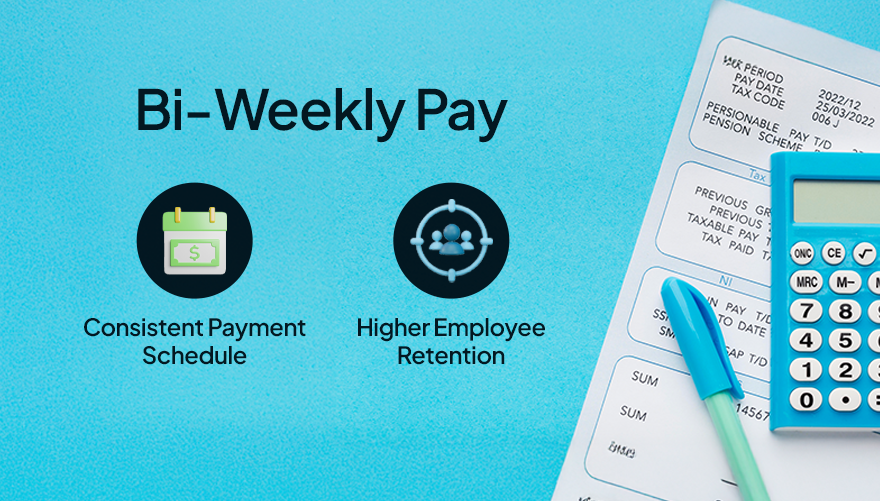Management of a business involves multi-folded operations and payroll management is one of the most important areas of it. The payroll cycle affects cash flow, budgeting, employee morale, and productivity.
Businesses employ a regular paycheck schedule or streamline the payroll with the expenses of the month to simplify processing. Payroll software based on AI offers automated scheduling, real-time performance monitoring, and compliance verification to ensure timely and accurate payments with fewer errors and less manual calculation time.
This blog will address the two most common payroll schedules, Bi-weekly and Semi Monthly Pay Schedule, discuss their pros and cons, and considerations you should consider making the optimal decision for your company.
What is Semi-Monthly Pay?

Semi-monthly compensation provides wages two times a month, usually on specified dates, to 24 pay periods a year compared to the 26 in bi-weekly compensation. Prevalent in salaried employment in finance, corporate, and administrative roles, the schedule best fits business planning for finances owing to its stability in earnings.
- Lower Payroll Processing Fee
It reduces payroll processing expenses. With twice-monthly payments companies process payroll two fewer times a year, which results in cost savings on payroll services and administrative work.
This is especially advantageous for those with third-party payroll services because charges are often per payroll run. Small businesses also benefit from this practice since infrequent processing saves them costs and allows HR and finance personnel to enhance efficiency without reducing employees’ satisfaction.
- Better Cash Flow
It improves businesses’ cash flow management by scheduling pay periods with monthly fixed expenses such as rent and utilities, making budgeting easier. The timing enables planned cash availability for payroll without financial pressure, especially for salaried employee companies.
In contrast to bi-weekly, which can result in three payrolls within a month, it is consistent by occurring on the same two dates, minimizing financial pressure and boosting stable cash flow.
Challenges That Businesses May Counter
Semi-monthly compensation has benefits but causes challenges for companies. One challenge is paydays on weekends or holidays, requiring premature payroll processing, which raises the workload for finance and HR. Further, it is complicated to compute overtime for employees paid on an hourly basis, potentially causing errors and long processing periods.
For companies with irregular or weekly cash flow, it can be a strain on finances since it can produce longer periods between paychecks than bi-weekly systems. But by implementing AI-based payroll software, they can simplify payroll calculation and improve accuracy to ensure timely payments.
What is Bi-weekly Pay?

It is where employees get their paycheck every other week, thus 26 paychecks in a year. For instance, if payday is Fridays, employees are paid every alternate Friday. It is preferred by most companies for its consistent and predictable income, which helps the employee’s budget.
This payment practice is prevalent in many industries, including retail, manufacturing, health, education, and hospitality. It compromises between regular payments and ease of payroll management, providing financial security for workers while enabling businesses to efficiently manage payroll expenses.
Advantages of Choosing a Bi-weekly Pay Schedule
Selecting the appropriate payroll schedule is important for companies. It is popular for its effectiveness, provides workers with steady wages every two weeks, which amounts to 26 periods a year. This improves cash flow, makes processing easier, and increases employee satisfaction, particularly in retail, healthcare, and manufacturing.
- Consistent Payment Schedule
It improves cash flow management for companies by tying payroll costs to a predictable schedule. Workers have regular paychecks every two weeks, which helps in personal budgeting and paying bills on time, reducing financial pressures.
This predictability simplifies accounting, minimizes payroll mistakes, and enables companies to make precise predictions about expenses, enabling enhanced financial control and allowing them to concentrate on growth instead of last-minute payroll issues.
- Higher Employee Retention
It improves cash flow management for companies by tying payroll costs to a predictable schedule. Workers have regular paychecks every two weeks, which helps in personal budgeting and paying bills on time, reducing financial pressures. Unlike semi-monthly pay, which can fluctuate with weekends or holidays, it is consistent. This predictability simplifies accounting, minimizes payroll mistakes, and enables companies to make precise predictions about expenses, enabling enhanced financial control.
Challanges Business Might Counter
It has several advantages but poses difficulties for companies, including higher payroll processing expenses due to 26 pay cycles in a year, resulting in more payroll service and admin activity expenses. Small companies can find it difficult to manage their cash flow, requiring enough money every other week to pay employees.
Artificial intelligence-based payroll software can reduce these problems by automating the processing of payrolls, monitoring cash flow, maintaining tax compliance, and forecasting payroll costs, thus reducing financial pressure and mistakes while ensuring accurate payments to staff.
BI-Weekly VS Semi-Monthly Which Suits Best for Your Businesses

Selecting the most appropriate pay schedule depends on businesses and employees, as factors like firm size, cash flow, industry practice, and employee choice can come into play. Businesses can consider their management of cash flow initially, with small firms potentially finding it helpful to pay semi-monthly or monthly as they allow for better payroll cost balancing, while firms with stable cash flow can choose bi-weekly pay for higher-frequency employee payments.
Industry practices also come into play; retail, healthcare, and manufacturing hourly jobs are generally on a bi-weekly cycle, while salaried workers usually want semi-monthly cycle to simplify budgeting. The cost of payroll processing must be factored as well, as more frequent pay increases administrative costs, so third-party providers will prefer the payroll to save on fees, in contrast to automated systems that can efficiently handle payroll.
How wAnywhere Can Help Streamlining Pay Schedule
Payroll management presents challenges such as intricate overtime calculations and coordinating pay periods with budget planning. wAnywhere, the best AI-powered employee tracking software, offers features to improve efficiency and accuracy in these operations. Proper time tracking is crucial, and it allows real-time monitoring of work hours, breaks, and auxiliary time.
Its attendance management uses AI facial recognition to minimize human errors, providing accurate payroll data, which makes payroll management. wAnywhere simplifies tracking, making it easy to comply with labor regulations and lowering administrative tasks. Payroll should be aligned with financial obligations, and it integrates smoothly with current payroll software, facilitating data transfer and reducing workload.
This allows companies to accurately project expenses and preserve cash flow. wAnywhere also includes application monitoring, geofencing, and automatic reporting features, which promote workforce accountability and efficiency in operations. In short, wAnywhere streamlines payroll handling minimizes administrative efforts, and ensures accurate employee pay with enhanced overall productivity and security.
Conclusion
Payroll management is a crucial aspect of managing business operation. It offers a timely pay schedule for employees, boosting their morale and job satisfaction. It is important for business to choose the best pay schedule based on their workforce and industry. Whether Bi-weekly or Semi-Monthly. Bi-weekly offers a consistent payment cycle and higher employee retention, whereas Semi-Monthly offers lower processing charge and better cashflow. It might be streamlining payroll management manually, and AI-powered software can be ideal solution to counter these challenges.
wAnywhere supports businesses in maintaining payroll schedules through automation of time tracking, automatic overtime calculations, integration with payroll systems, and improved productivity and security. This combined comprehensive strategy lowers the administrative workload while ensuring accurate and timely employee payment.
wAnywhere Blog
Check out the wAnywhere blog to learn more about our product, customer stories, and our take on meetings, remote working, productivity, and more.

